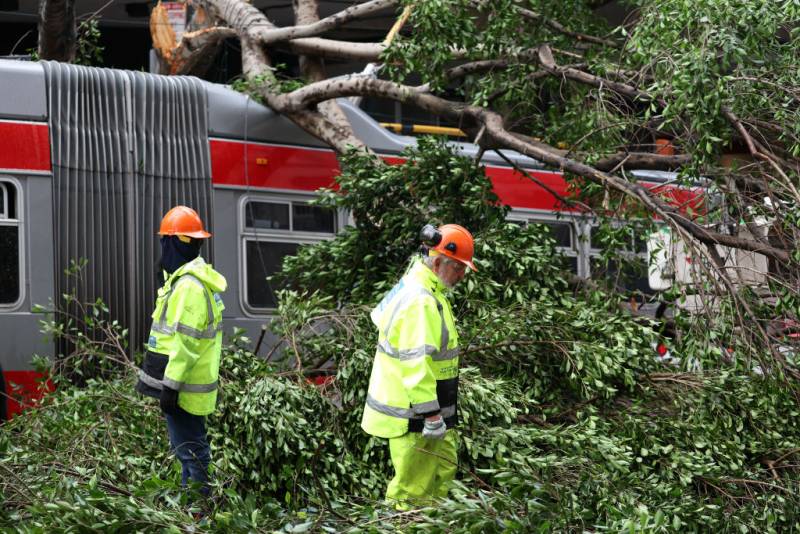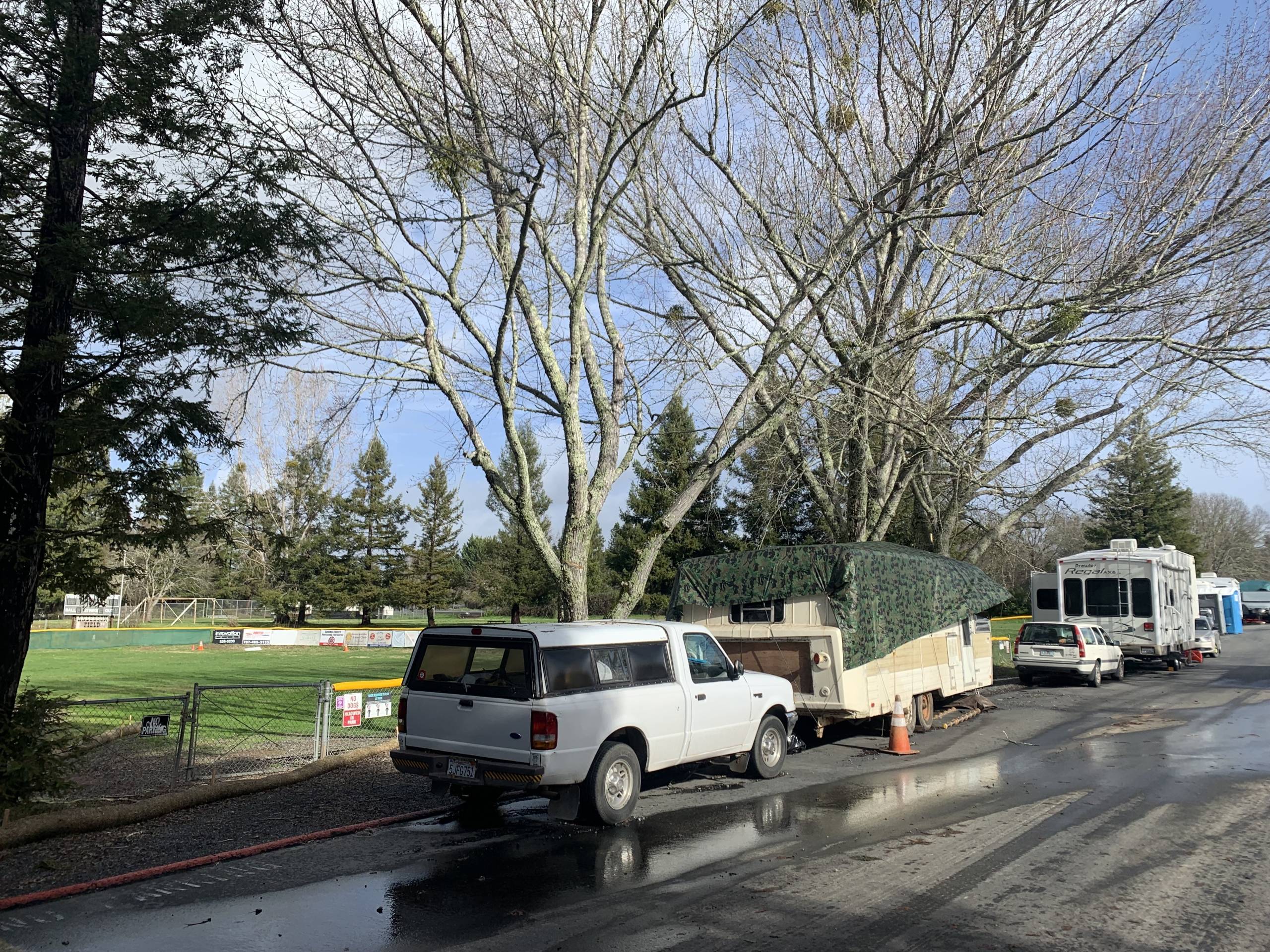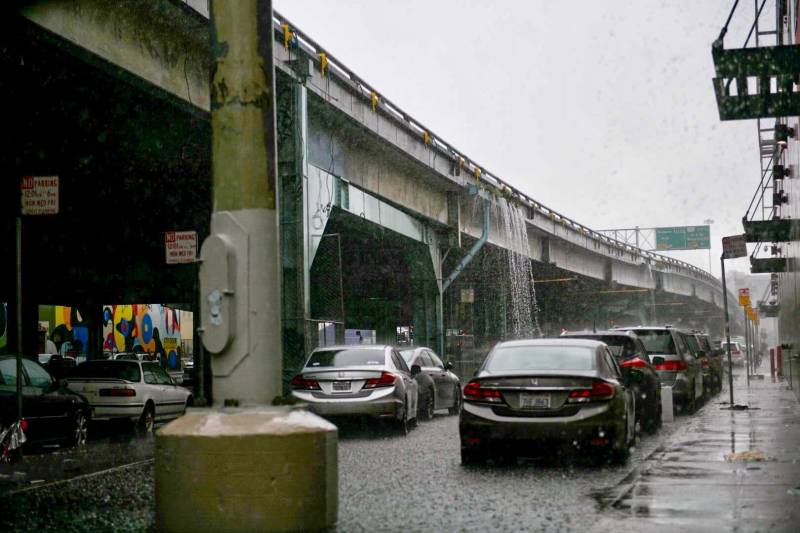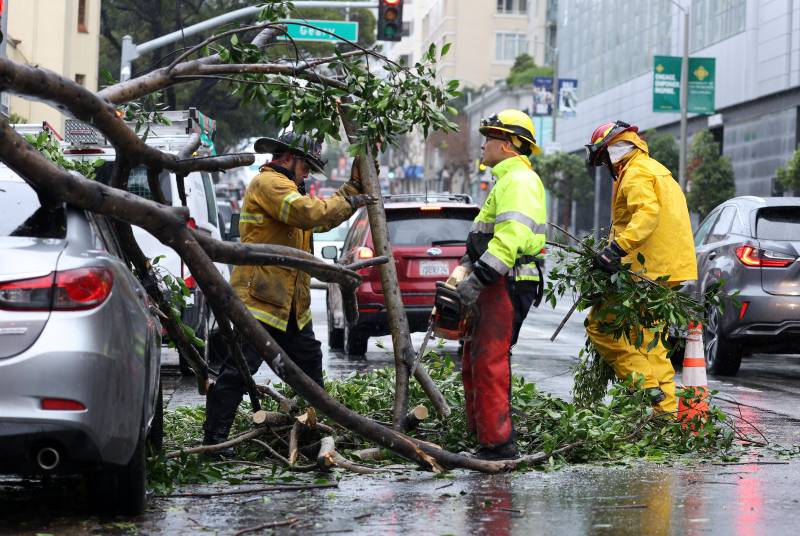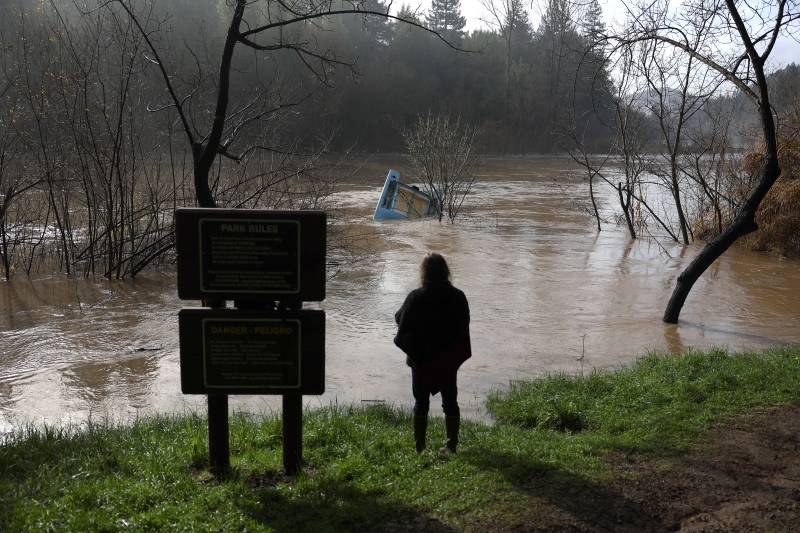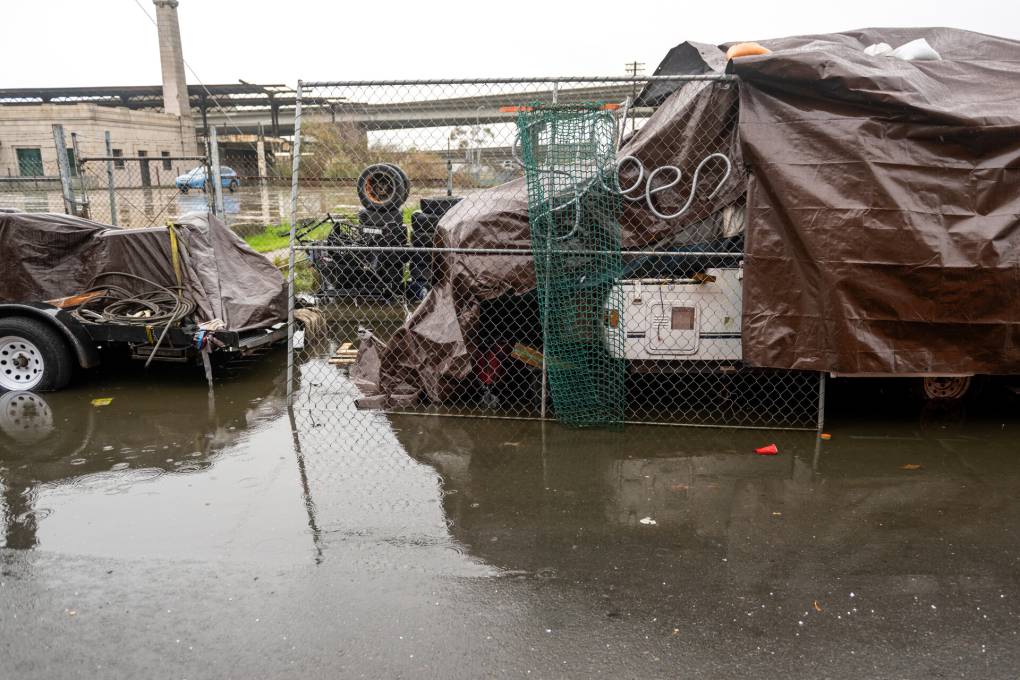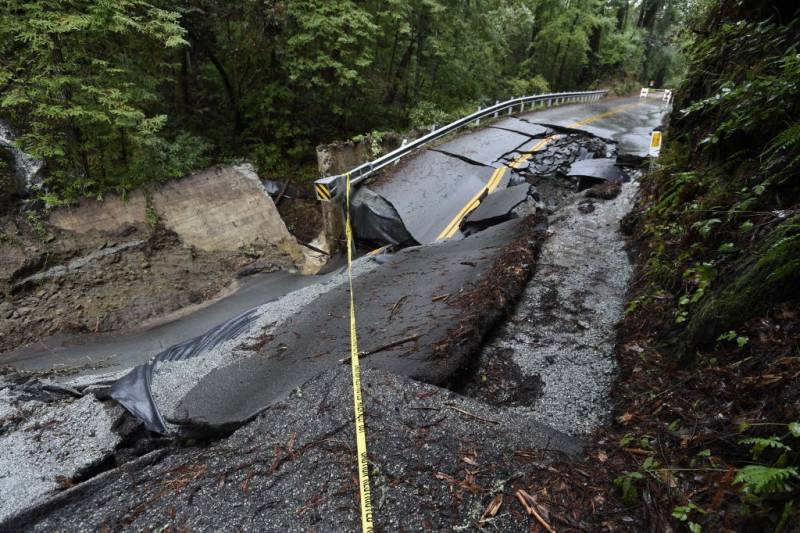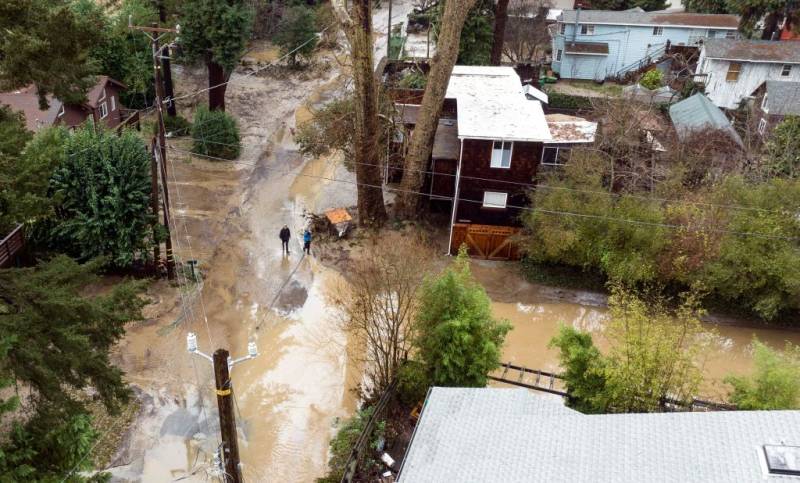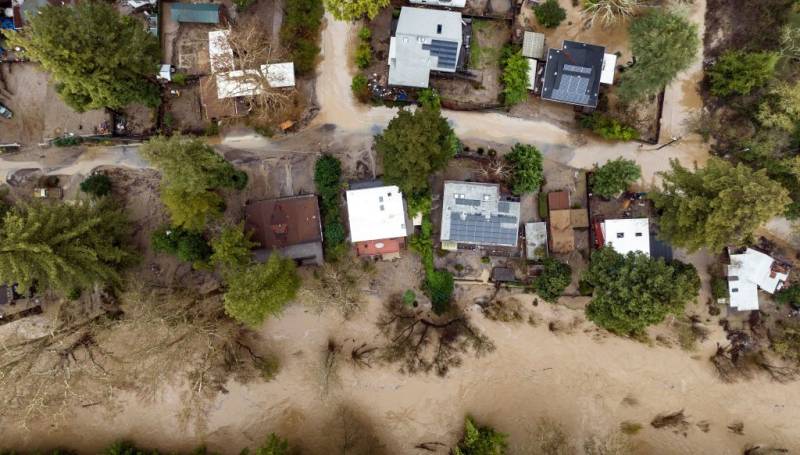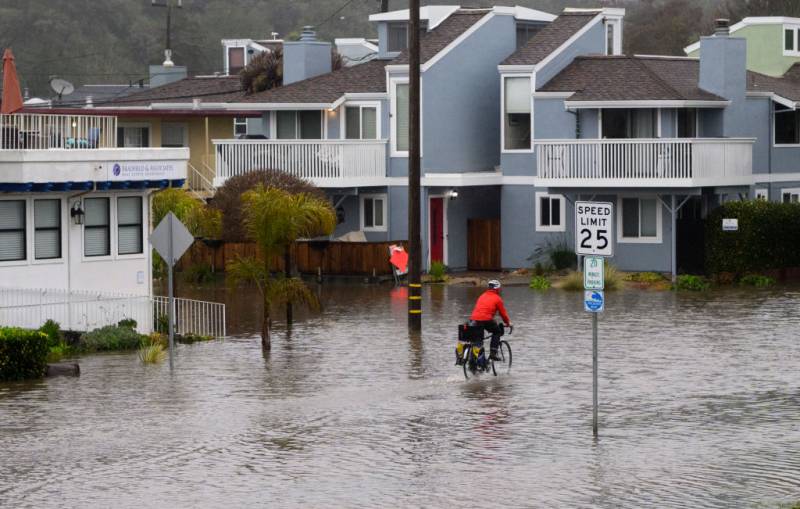This story will no longer be updated.
Update, 6:15 p.m. Wednesday: The body of a 43-year-old Ukiah woman was recovered from a submerged vehicle in Forestville today, according to the Sonoma County Sheriff’s Office.
Dispatch reported receiving a 911 call from a driver that her car was stuck in floodwaters in the 6000 block of Trenton-Healdsburg Road, Forestville. The caller reported there was water in the car before the line was disconnected. Dispatch immediately tried to call back several times with no response.
Deputies from the Sheriff’s Office, fire personnel from Sonoma County Fire District and the California Highway Patrol arrived Tuesday but couldn’t locate the vehicle, calling off the search at sunset when it became too dangerous to continue. The search resumed Wednesday when they found the vehicle submerged in 8–10 feet of flood water approximately 100 yards off the road.
The woman was identified as Daphne Fontino by the Sonoma County Coroner’s Office, according to a news release from the Sonoma County Sheriff’s Office. This brings the total number of confirmed deaths as a result of storm events since Dec. 30 to 19, the Los Angeles Times is reporting.
This morning we found a in a submerged car in the 6000 block of Trenton-Healdsburg Road, Forestville, with one occupant who had died. The occupant is Daphne Fontino, 43, Ukiah. Our deepest condolences to her family and friends. Details on our Facebook page. pic.twitter.com/BO7qmJdvnG
— Sonoma Sheriff (@sonomasheriff) January 11, 2023
In Hollister last night, a swift water rescue team made up of personnel from the Oakland Fire Department and members of seven other local agencies rescued two men after their truck was overwhelmed by fast-moving floodwaters in the vicinity of 595 Hospital Road, according to the City of Oakland.
The vehicle became stuck and was subsequently submerged in high water as the two passengers found themselves trapped on top of the vehicle. The rescue team used multiple ladders and other technical rescue tools to reach them and help them to safety. The men declined medical treatment but did not appear to be suffering from any injuries.
“The technical skill and communication involved in the rescue was phenomenal, and I hope this incident is a reminder for everyone about the dangers of attempting to drive through powerful and unpredictable storm water,” said Oakland Fire Chief Reginald Freeman.
Meanwhile, Pacific Gas and Electric said power outages continued to affect more than 15,956 customers in the Bay Area as of 4 p.m. Wednesday, 13,059 of whom are in the South Bay, with 1,304 PG&E customers without power in the North Bay, 1,457 on the Peninsula, 131 in the East Bay, and five without power in San Francisco.
Update, 4:45 p.m. Wednesday: The PBF refinery in Martinez has released more than 11 million gallons of refinery-processed wastewater and storm water into the Carquinez Strait during the successive storms that have slammed the region over the last two weeks, according to the latest estimates from Bay Area water regulators.
That’s close to double the estimate from last Friday — the same day local residents complained of an odor coming from the facility, which has had a number of significant spills in recent years.
Eileen White, executive officer of the San Francisco Bay Regional Water Quality Control Board, said the discharge volume is now up to 11.2 million gallons for the Martinez refinery, but emphasized that “everything is still estimated.”
White also confirmed that Chevron’s Richmond refinery is releasing wastewater into the bay as well, but it’s still unclear how much.
“It sounds like it’s ongoing, so we won’t have a spill volume until later,” she said. “Everyone’s still in the response mode, with three more atmospheric rivers forecasted for the next week.”
The spills are among a number of local instances in which the recent torrential rains have overwhelmed infrastructure like storm drains, sewer lines and treatment plants, forcing significant amounts of wastewater into local waterways.
Update, 1:40 p.m. Wednesday: Another day, another storm. Wednesday delivered more heavy rain to much of the Bay Area, a day after the region was hit with an extremely rare cocktail of hail, thunder and lightning.
Yesterday’s storm system, part of the recent unrelenting series of atmospheric river events blasting California, has now moved well inland and is currently bringing mountain snows across the Intermountain West and into much of the central Rockies.
But now, “an enormous cyclone rotating well off the West Coast” is responsible for this latest round of heavy precipitation and gusty winds in Northern California, according to the National Weather Service. The North Bay is forecast to get the worst of today’s storm, with the potential for 2–3 inches of rain through the day, along with up to another 2 inches on Thursday.
About 2–3 inches of rain are expected to fall in the East Bay Wednesday, along with 1–2 inches in Santa Cruz County and up to 1.5 inches in the South Bay, in San Francisco and down the Peninsula.
Aside from the North Bay, Thursday should bring a brief respite (relatively speaking) to the rest of the Bay Area, with just 0.1–0.5 inches expected, before another storm front moves through the region Friday through Sunday. That storm is expected to drop 1–2 inches in San Francisco and on the Peninsula, 1.5–3 inches in Santa Cruz County, and 1–2 inches in the South Bay.
Meanwhile, in the North Bay, up to 4 inches are expected over the weekend, spurring new concerns of the Russian River flooding. The National Oceanic and Atmospheric Association/NWS California Nevada River Forecast Center had predicted the Russian River would experience a double-crested flood, but that prediction has been revised and the Russian River is not expected to reach flood levels again in the coming days. As of Wednesday, the Sonoma Sheriff’s Office lifted the evacuation warning for all residents living near the Russian River floodway and its tributaries just south of Healdsburg to Jenner.
Full school closures in four school districts of Sonoma County remain in place Wednesday “due to storm related impacts,” according to the Sonoma County Office of Education. The affected school districts are Fort Ross Elementary, Horicon, Kashia and Montgomery Elementary, with no virtual or in-person classes. The school districts have been closed since last week, with Horicon since Jan. 4 and the others since Jan. 5. The announcement included the caveat that officials at school districts make decisions independent of the county office.
As #GOESEast monitors the U.S. today, a storm system associated with recent atmospheric river activity has moved well inland, bringing rain and mountain snow across the Intermountain West and into much of the central Rockies.
Latest: https://t.co/wJGBXDcNu2 pic.twitter.com/BBXfXHUw66
— NOAA Satellites (@NOAASatellites) January 11, 2023
Update, 5:30 p.m. Tuesday: A rare display of hail, thunder and lightning hit parts of the Bay Area on Tuesday, the latest wrinkle in a series of dramatic winter storms that have slammed the region with heavy rain and high winds.
Pea-sized hail fell in numerous cities in the area, including in Berkeley, but no damage was reported as a result.
